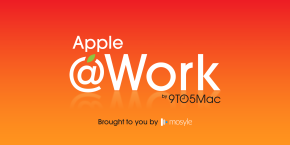
Backing up corporate data isn’t a luxury. It’s not only essential, if you lose data, you could possibly open yourself up to legal matters. In a world of mobile devices, remote working, and cloud services, how do IT departments build a system for Mac backups in the enterprise?
About Apple @ Work: Bradley Chambers has been managing an enterprise IT network since 2009. Through his experience deploying and managing firewalls, switches, a mobile device management system, enterprise-grade Wi-Fi, 100s of Macs, and 100s of iPads, Bradley will highlight ways in which Apple IT managers deploy Apple devices, build networks to support them, train users, stories from the trenches of IT management, and ways Apple could improve its products for IT departments.
Is Time Machine usable in the enterprise?
Time Machine is Apple’s built-in tool for backing up Macs to an external drive. While I love it personally, it just doesn’t scale well in large environments. If you have more than a handful of users, it’ll be difficult to ensure that the backups are happening properly and restoration is being tested. I highly recommend it for personal devices and very small environments, though.
One of the aspects I love about Time Machine is how quick it is to recover from when using USB 3.0 or Thunderbolt. But without a more scalable way to monitor the backups, it’s a poor solution for Mac backups in the enterprise.
Are cloud backups an option?
I use Backblaze to back up my personal Mac, but they also offer business plans. For remote teams, if you have local data you need to backup in a secure manner, Backblaze would make a great option. Their app is native to the Mac, it supports unlimited storage, a web-based portal for management, and single-sign-on through G Suite or Microsoft.
It’s $60 per year per user. If you want a turn-key solution for Mac backups in the enterprise, Backblaze is a great option for a cloud-based solution.
Wrap-up on Mac backups in the enterprise
An approach that is the most ideal solution is to have no data that is local to the machine. Documents should be in a solution like Google Drive or OneDrive. Email is stored on a server elsewhere. If a machine goes down and needs repair, an employee should be able to get access to all of their data without needing to restore. Using a solution like Jamf Connect to quickly log back into a new Mac, they should be able to get their apps installed and get access to their data. I was able to trust this process when we had multiple staff members lose their homes in Tornados that recently hit our city. There wasn’t a Mac to migrate, so I had to set their devices up as new. Using Apple School Manager, Jamf School, and Google Drive, deploying and file restoration was a straight forward process.
So the answer to how to build Mac backups in the enterprise is to design your systems where no back up at all is needed. If you do need a scalable solution, check out Backblaze.
FTC: We use income earning auto affiliate links. More.






Comments